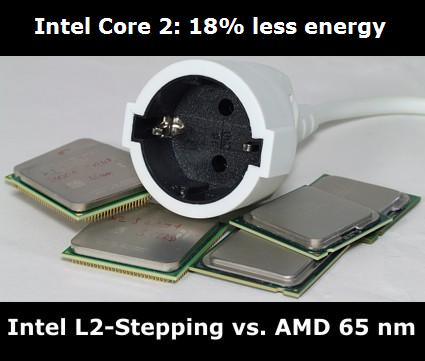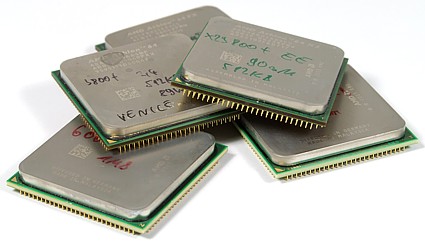Energy Efficiency: AMD vs. Intel
Energy Efficiency: AMD vs. Intel
Intel Disappoints in Energy Efficiency
For several years, Intel was unable to keep the energy requirements of its processors low. One reason can be found in the unfortunate 90nm Pentium 4 Prescott design. Additionally, Intel implemented only a small range of energy saving features, which resulted in only minimal savings at the end of the day.
AMD, on the other hand, was able to shine in this green discipline ever since the introduction of its Athlon 64 line of processors with their Cool-and-Quiet functionality in 2003, leaving Intel far behind. However, three quarters of a year ago, Intel launched its Core 2 processors. The power demands of the current incarnation of this micro architecture, dubbed Conroe, are dramatically lower than that of its predecessors. Accordingly, the Core 2 line is considered a highly efficient processor.
However, although the Core 2 is a very efficient processor and possesses very intelligent power management features, such as the ability to deactivate unused areas of the cache, it still draws up to 24 watts in idle mode. As a result, the entire line of Intel's desktop processors still lag far behind AMD's offerings in this respect.
In order to remedy this situation, Intel recently introduced a new stepping of its Core 2 processors. According to the chipmaker, the new so-called L2 stepping is able to reduce the processors' power draw to a maximum of 12 watts when idle - only half of what the previous stepping used.
So far the newer stepping is only found in the lower-clocked Core 2 models. It would seem that implementing the power-saving features in the bigger, faster models is proving more difficult.
In this article we measure the power consumption of Intel's new L2 stepping and compare it to other Intel and AMD CPUs currently available in the market.
In order to facilitate this comparison, we took exhaustive measurements and put the results into extensive charts to highlight the following points:
Get Tom's Hardware's best news and in-depth reviews, straight to your inbox.
- Energy efficiency
- Overall power consumption
- Energy cost
- Processor price/energy cost index
- The correct main board
We conducted all measurements under a variety of load scenarios in order to determine the best processor for different tasks, such as office productivity, high-performance/gaming and low-energy PCs.
Ultimately, we wanted to find out whether buying a special low-power CPU is actually worth the investment.
Current page: Energy Efficiency: AMD vs. Intel
Next Page Energy Efficiency: AMD vs. IntelTom's Hardware is the leading destination for hardcore computer enthusiasts. We cover everything from processors to 3D printers, single-board computers, SSDs and high-end gaming rigs, empowering readers to make the most of the tech they love, keep up on the latest developments and buy the right gear. Our staff has more than 100 years of combined experience covering news, solving tech problems and reviewing components and systems.



